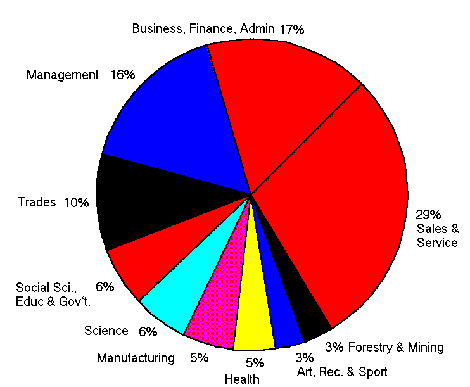
THE STRUCTURE OF THE NOC
Skill types are:
0 - Legislators and Senior Management
1 - Business, Finance, and Administration
2 - Natural and Applied Sciences and Related Occupations
3 - Health
4 - Social Science, Education, Government Service, and Religion
5 - Art, Culture, Recreation, and Sport
6 - Sales and Service
7 - Trades, Transport, and Equipment Operators and Related
Occupations
8 - Occupations Unique to Primary Industry
9 - Occupations Unique to Manufacturing, Processing and Utilities
Skill levels are:
Skill Level A (1) - University education
Skill Level B (2 or 3) - College level education including trade
apprenticeships
Skill Level C (4 or 5) - Secondary school plus a period of
job-specific training
Skill Level D (6) - Short work demonstration (no formal education
required)
Example of larger fields with "low"
growth compared to a smaller fields with "high" growth
B.C. 1995 - 2001
|
|
|
|
|
|
Secretaries |
|
|
|
|
|
Systems Analysts |
|
|
|
|
|
Athletes |
|
|
|
|
|
EEG/Other Diagnostic Technician |
|
|
|
|
|
NOTE: The secretaries occupational
classification (NOC code 1241) falls within the major two digit
NOC of Skilled Administrative and Business Occupations, and
includes Executive Secretaries and Technical Secretaries. These
more highly skilled administrative occupations require one or two
years of post-secondary secretarial/business training and/or
several years of previous clerical experience. This occupational
classification does not include the lower skills clerical
occupations such as general office clerks (NOC code 1411), and
word processing operators (NOC code 1412).
Projected Number of Job Openings
